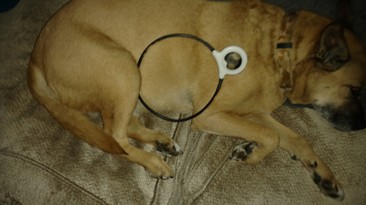Kristi Wilson, DVM

Kristi Wilson, DVM is a small animal general practitioner with a special interest in integrative medicine. She is a 2002 graduate of Texas A&M University College of Veterinary Medicine.
Assisi Animal Health: We’ve been so encouraged by the reports that you’ve given us so far that it felt really important to make sure we had time to learn from you. Let’s start with you telling me about the case that really helped you decide that this was a therapeutic tool that you wanted to integrate into your practice.
Dr. Kristi Wilson: I’ve been in private, small animal practice for 15 years. Five years ago, my family had an event where my children were sick and my husband was sick. As a conventional practitioner at the time, I always had followed conventional practices with my family’s health as well as my work practices. When my family members were sick, the conventional route of therapy did not provide any hope for us. The plan was to suppress symptoms with medication and pharmaceuticals that all carry side effects. We had to do better than that!
And so, we were on a quest for health and our goal was to avoid the side effects caused by medication. What we found with our human family was that there is a lot you can do! A lot of conditions that we are dealing with today rooted in inflammation, and there are actually a whole bunch of modalities that you can utilize to control inflammation that carries no risk. Those things provide hope, and they’re also less risk.
I had become familiar with acupuncture and the role of diet in inflammation and I also had experienced success with our class IV therapeutic laser in practice. A client that came in from another practice in Michigan. She was using the Assisi Loop on this dog to control pain in its stifles. She said, “Can I get this through you guys?” And I said, “Huh, what is that?” I thought the owner had credibility because she was a medical doctor, and she had researched the product and she believed that it really helped her dog. I looked into it myself and I was really impressed with it.
I looked at the brochure that you guys put out, and then I looked further on the human research regarding pulsed electromagnetic field therapy, and I noticed there was a lot of evidence that this type of therapy decreases healing time after bone fracture repair, as well as it’s been used post-operatively in mastectomy patients. The role of pulsed electromagnetic field therapy in the Nitric Oxide cycle for the inflammatory cascade made sense to me. I was also excited because I had experience with laser in practice and I had been very impressed by the results that I was getting. We have a class 4 therapeutic cold laser. But the laser has limitations, for example, you have to bring your pet to the hospital to use it, and also it is contraindicated for neoplasia. I was encouraged by this device because I had patients that could have benefited from the laser, but it didn’t work for the owners practically. Also, it could have been, for certain animals, contraindicated if they had a history of cancer. So, having awareness in my human life of acupuncture and alternative remedies to control inflammation, having positive results using my class 4 therapeutic laser, and then finding this device, it just all made sense to me that this would be something we could try.
Did you purchase or prescribe the Loop for that particular client? And then how did you continue to explore the benefit from there?
Yes, I purchased the Loop for that particular client, and then one of the earliest cases that I used it for was a dog named Spice, an eleven-year-old, spayed female, boxer mix. She had had an acute collapse and had an abdominal hemorrhage. She had been to a radiologist and had an ultrasound, and the ultrasound indicated that she had infiltrated liver disease, which was most likely neoplastic. Histiocytic Sarcoma is what the radiologist expected it to be based on that ultrasound findings. Her prognosis was grave. The owner came to me looking for something to do besides the traditional medical workup. She did not want to pursue a liver biopsy, she wanted to provide her dog palliative care for as long as possible.
 I examined Spice and reviewed her history. The liver bleed that she had was an acute abdominal hemorrhage, which resolved itself without treatment, but the underlying disease was still there and she was still lethargic and not herself. We comprised a plan for Spice that would be anti-inflammatory and catered toward a dog that has cancer. She had been eating a grain-containing kibble and we switched her food to high-quality grain-free. The owners started supplementing her with a lot of home-cooked food, organ meat, and other fresh foods. She started taking a Chinese Herb called Yunin Bao to control hemorrhage. In addition to that, we put her on a supplement called Onco support by RX Vitamins and curcumin, which is a derivative of turmeric and is anti-inflammatory. We also used the Assisi Loop on her abdomen. Her abdomen was distended, and her liver and spleen were both enlarged.
I examined Spice and reviewed her history. The liver bleed that she had was an acute abdominal hemorrhage, which resolved itself without treatment, but the underlying disease was still there and she was still lethargic and not herself. We comprised a plan for Spice that would be anti-inflammatory and catered toward a dog that has cancer. She had been eating a grain-containing kibble and we switched her food to high-quality grain-free. The owners started supplementing her with a lot of home-cooked food, organ meat, and other fresh foods. She started taking a Chinese Herb called Yunin Bao to control hemorrhage. In addition to that, we put her on a supplement called Onco support by RX Vitamins and curcumin, which is a derivative of turmeric and is anti-inflammatory. We also used the Assisi Loop on her abdomen. Her abdomen was distended, and her liver and spleen were both enlarged.
The owner said as soon as she started using the Assisi Loop, her bark changed and she had more energy within a day. And with the diet and the supplements that we put her on, the owner said that on this regime she was better than she had been prior to her diagnosis, prior to her going down with the acute hemorrhage. The owners didn’t realize that over time she had to become quite lethargic. They said after they started this regime for her she was like a puppy again, running around, chasing a ball, doing all the things that she loved to do.
At one point, the Loop stopped working because the wire broke and the owner could immediately tell it wasn’t working because she went back to her old self. She came into the office and she said: “I need one of those Loops right away because I can tell this one is not working.” Immediately we gave her a new one and then within a day, Spice was back to herself. That was April of 2016 [one year before this interview]! Spice had been given a grave prognosis, and the radiologist verbally told the clients she had about a month to live. We are happy to report, she is still alive and well today! We have the video of her playing ball with her owners and living the typical dog life. She’s doing great, and her owners couldn’t be happier. They’re very faithful with the routine and use the Loop three times a day religiously. They always use it over her abdomen, over the region of her liver, and they rotate it around in different places depending on how she’s laying. They just put it on her depending on whatever is comfortable for her at that time, so it ends up being kind of all around her abdomen.
Interesting. Would you say why they were sticking with three times a day rather than tapering down? Just out of an abundance of caution, or have they experimented with tapering down?
They have experimented with tapering down and they noticed that she doesn’t do as well.
Okay. Great. So, they were able to find what I call the “sweet spot.”
 They occasionally will miss a treatment and they can tell a difference.
They occasionally will miss a treatment and they can tell a difference.
When you have a pet owner that sees a difference within a day, they tend to be committed to managing the treatments and keeping on top of them.
Oh yes, they’re very committed to the treatments.
Have you had some cases where it’s taken longer for them to see the results, but they were able to get there and continue the treatment?
Yeah, those are the hardest ones. I especially find OA in big dogs to be one of those that people don’t always commit to for the long haul and get frustrated and kind of peter out. But the people that do, they notice that it works.
I have another little 10-year-old Chihuahua named “Molly.” She has severe OA of her rear legs. Molly was having trouble going up the steps and when her owner brought her in she said, “she just doesn’t seem happy.” Molly also had a history of some digestive problems and elevated liver enzymes, which limited our ability to treat her with oral pain medication. I talked to her owner about trying the Assisi Loop. I’ve had some tremendous results with little dogs like her, or cats because their whole body fits inside that Loop and it treats the whole dog. Molly’s owner is very dedicated to her treatments, and it has made an amazing difference in her life! Molly runs around again, up and down steps, and best of all her owner says, “she is happy again!” Interestingly enough, her liver enzymes also improved after starting the loop….it makes sense, since the device is anti-inflammatory.
You mentioned the ability to put a small dog or a cat in the middle of the Loop and you can treat the whole animal. That is something we’re always mindful of, particularly when we’re working with feline patients. Do you have any feline cases that you’ve used the Loop with?
 I believe the Assisi loop is a tremendous asset to older felines. Greater than 80% of geriatric cats suffer from osteoarthritis (OA). They are so limited with long term pain management available to them. In addition to OA, most older cats suffer from some degree of renal insufficiency. Considering that renal disease is inflammatory in origin, it makes sense that the Assisi loop can benefit the kidneys as well. When you take old cats that are suffering from both things, or one or the other, they can definitely benefit from a treatment in the Assisi Loop to treat their whole body. The Loop also gets their bowels moving, which is one more benefit! The Loop is the perfect size for them. I have them put it on the whole back half of the cat. They can put it under the cat, around the cat, or on top of the cat. The older felines are some of the most rewarding cases! I’ve had owners call to thank me for rejuvenating their cats!
I believe the Assisi loop is a tremendous asset to older felines. Greater than 80% of geriatric cats suffer from osteoarthritis (OA). They are so limited with long term pain management available to them. In addition to OA, most older cats suffer from some degree of renal insufficiency. Considering that renal disease is inflammatory in origin, it makes sense that the Assisi loop can benefit the kidneys as well. When you take old cats that are suffering from both things, or one or the other, they can definitely benefit from a treatment in the Assisi Loop to treat their whole body. The Loop also gets their bowels moving, which is one more benefit! The Loop is the perfect size for them. I have them put it on the whole back half of the cat. They can put it under the cat, around the cat, or on top of the cat. The older felines are some of the most rewarding cases! I’ve had owners call to thank me for rejuvenating their cats!
It is definitely nice when you can have an option for cats and other animals who are NSAID intolerant, and that’s really one of the benefits of the Loop. It can be used in conjunction with NSAIDs, but it also is a really great alternative for the animals that can’t take NSAIDs.
When you talk to pet owners about the Loop, how does that go? What kind of process is involved to kind of get them on board with it?
Well when I have a pet with chronic pain, I really love a multi-modal approach with the least number of side effects. If I have a pet that comes in acutely and is really hurting, I will definitely use NSAIDs if they have bloodwork that allows that. I talk to the owner about using the NSAIDS to get the initial pain under control and then using other modalities to carry it over, so that we can minimize the long-term use of NSAIDS. My goal is for the pet to have the highest level of pain control, with the lowest level of risk. When I talk to pet owners, I tell them there are several modalities to pain management and that the most effective way to manage pain is multi-model. I recommend that they feed a high protein, grain-free diet to support muscle mass and reduce inflammation. I also recommend that they give supplements that are anti-inflammatory. Sometimes I add gabapentin or amantadine for additional pain control.
And then I talk to them about doing some sort of energy support for the inflammation, which would be either acupuncture, cold laser, or tPEMF. I definitely try to tailor the treatment plan to the case and make sure it is appropriate for the patient and the owner. I have them talk to me about what their lifestyle is like, what their relationship is with their pet, what their ability is to do certain things. If it’s a pet that loves to come to the vet and it’s a great big dog and it has OA affecting its knees and neck and shoulders, then I would speak to them about doing the laser. If It’s an older cat with OA, I’m going to talk to them about using the Assisi loop at home. If it’s a large-breed dog that has OA in just one joint, then I will talk to them about the option of doing the laser in the hospital or Assisi at home. Sometimes I’ve even used a combination of laser, acupuncture, and/or Assisi to get the initial pain under control. This is especially helpful in situations where pets have concurrent health problems that limit pain management options.
 I know you’ve talked about some who have been pretty immediately or quickly impressed with this therapy, whether it be a standalone or part of a multi-model. Have you had other clients who’ve maybe struggled with seeing the benefits?
I know you’ve talked about some who have been pretty immediately or quickly impressed with this therapy, whether it be a standalone or part of a multi-model. Have you had other clients who’ve maybe struggled with seeing the benefits?
Yes, I think that the cases that are more frustrating are the chronic osteoarthritis patients, especially in large dogs. In the small animals, you’re able to hit multiple joints at a time, and the depth of penetration is excellent. I feel those are very rewarding, those owners typically really notice it, with cats and small dogs. Owners are usually more willing to comply when they see results. Large breed dogs with OA in multiple joints, sometimes it is not practical to adequately address their pain with the Assisi Loop. In any case, chronic OA takes longer to respond to treatment. Owners must be patient and committed to noticing a difference, and it can be hard to get them to comply if they are not seeing immediate results. Some patients can take 2-4 weeks of regular treatments before the results are noticeable. It is important to discuss with owners so they have realistic expectations.
What are some situations that you might notice more immediate results?
We have had excellent results fairly quickly for soft tissue problems. For example, in feline cystitis, feline asthma, wounds or trauma, and pancreatitis. Owners are usually very happy with the results!
We also used this in clinic post-operatively for any kind of tumor that we remove that we’re not sure on the pathology. We typically do a post-op laser on our spays and neuters. For all of our lumpectomies, we use the Assisi Loop, since there are no contraindications with neoplasia.
What’s your protocol for that?
We typically will do it immediately post-op, as long as there’s no active bleeding, and then depending on when the patient leaves, sometimes we’ll repeat it three or four hours later.
Have you ever sent it home with a client post-op?
Not yet post-op, but I actually have sent it home with a client as a rental for other acute conditions. I had one client that took it home for rental when her dog had pancreatitis, and never brought it back because it helped her dog so much, she didn’t want to part with it! So typically, the way we charge it is weekly, but they have to leave a deposit for the whole amount. So, if they keep it, they end up just buying it.
Say more about the client who saw really good results.
The Assisi Loop was very helpful in that case. She was a small dog, and the owner noticed a difference in her behavior after the first treatment. She was so much more comfortable! You know with a laser, in order to get good penetration for pancreatitis, you have to press on their abdomen. When a dog has pancreatitis, that’s pretty uncomfortable. There is no pressing with the Assisi Loop!
How interesting. And so, how do you determine when you’re going to offer it as a rental opposed to recommending that they purchase the Loop?
I usually offer it both ways, but sometimes it’s an acute condition where I don’t really feel like they’re going to need it for 150 uses. I just feel like it would help the pet. For example, if I had a cat with a bite abscess that was having a hard time healing, I would send home an Assisi Loop. They’re not going to need 150 uses, but it would really benefit that cat to have it for a week. So, if I feel they’re not going to need it for the whole duration, then I’ll do it as a rental. But I will also discuss it with people and give them the option to either rent it or buy it. Rental is less expensive than buying the whole thing. Some people don’t want to make the investment to purchase a new one.
So, it sounds like you’ve found a way to tailor how you’re prescribing is based on the client’s needs and compliance as well as the patient’s condition. And then you’re also able to really determine a program that might be able to manage financially as well. Being able to rent versus buying, and those kinds of things, you’ve been very creative with that.
 Thank you. My goal as a veterinarian is to provide care for their pets as if it were my own pet. I want to give them a solution that is going to be doable for them. I think you really have to meet people where they are because for some people compliance is not a problem at all, and for some people, the Loop just doesn’t work because they can’t make the commitment to do it. If people are not able to comply I don’t want to dispense the Loop to them, because I don’t want them to be frustrated and feel like I have done them a disservice by giving them this device and having them pay for it when it’s not something they can logically and realistically do.
Thank you. My goal as a veterinarian is to provide care for their pets as if it were my own pet. I want to give them a solution that is going to be doable for them. I think you really have to meet people where they are because for some people compliance is not a problem at all, and for some people, the Loop just doesn’t work because they can’t make the commitment to do it. If people are not able to comply I don’t want to dispense the Loop to them, because I don’t want them to be frustrated and feel like I have done them a disservice by giving them this device and having them pay for it when it’s not something they can logically and realistically do.
That sounds wise. We have the same beliefs. If we feel it won’t benefit, we would recommend against it, whether it be because the animal isn’t appropriate, the condition isn’t appropriate, or the pet owner may have a challenge. Is there anything else you want to say about your experience with the Loop that’s important for other people to understand from your perspective?
Another condition which I didn’t mention is feline asthma. The Assisi Loop really benefits those patients!
Say more about that.
With feline asthma, you can use oral prednisolone or you can use inhaled steroids. Inhaled Steroids are really costly. They don’t have the side effects of the oral prednisolone administration, but last time I checked the most commonly prescribed inhaler, Flovent, a month supply was about $300. And also, some cats don’t like the sound that that inhaler makes and they’re very scared by it. I have had very good success using a combination of diet and Assisi Loop to treat feline asthma. For acute situations, I start them on oral prednisolone, change them to a grain-free/high protein diet, and start the Assisi Loop. I usually also add an Omega 3 Fatty Acid supplement. Most of the time, I am able to completely wean them off, or significantly reduce steroids and maintain them with diet and Assisi treatments alone.
 And what’s the protocol you’ve used for asthma?
And what’s the protocol you’ve used for asthma?
For feline asthma I have them treat 3-4 times a day for the first two weeks and then every two weeks I have them drop one treatment and see how it goes. And if the symptoms come back, then they know that that wasn’t going to work for their pet. But for many patients it depends. For example, with pancreatitis a lot of times you can resolve it and they don’t need the Loop anymore after a few weeks. With feline asthma, it may be seasonal. So, it may be something where they need to use that regime certain times of the year. Then they can just leave it in a drawer and use it again the next season that’s problematic for that cat. The treatment protocol is definitely variable depending on the needs of the animal and the chronicity of the disease.
That’s great. Thank you for that. Anything else that you want to share?
I’m a huge believer. There is a lot of promise for the future of tPEMF for humans and animals. It’s going to go right along with all the biologics and things that people are using to encourage the body to heal itself. We haven’t even tapped into the full potential for this device and modality of treatment. I am excited that it’s available and that it is another option for us as veterinarians.
I agree. It’s exciting to be a part of it, honestly. It’s been really great.
